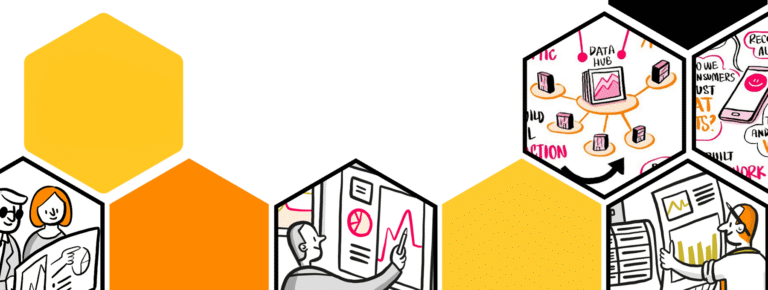Did you know that 82% of consumers expect retailers to meet their needs and desires? The success of your ecommerce business largely depends on how well you know your customers. Read on to discover a step-by-step plan for using persona mapping to optimize your customer experience.
Why Persona Mapping is Important
Persona mapping allows you to identify the typical user of your interface better and zero in on your target audience. Personas allow us to build designs based on the needs and desires of your customers.
For the best results, you should construct your personas at the beginning of your project. For optimal results, we recommend you create 3-5 personas.
The most effective methods to glean analytics to support your persona are
- interviews
- surveys
- analytics
- research
Related Reading: 5 Keys to Building an Exceptional Ecommerce Customer Experience
UX Persona (User) Mapping
Mapping a user, or a persona, helps you understand how a visitor will use your page, and ultimately, how-to guide them to purchase. While the personas are fictional, you should generate them from actual data. If you create personas without the research to back them up, they will represent imaginary users, not your actual customers.
The data collection for persona mapping depends on the resources allocated to your project. The best-case scenario that will generally produce the most in-depth results includes interviews. The method that will generate the less concise data involves investigating social media to glean the same kind of data that interviews would yield.
The fields you choose to include or exclude from the persona are entirely up to you. None of them are mandatory besides the image and name as identifiers.
Next, we have outlined the most commonly used fields: demographics, psychographics, triggers, and custom fields.
The Demographics
When building a persona, you must first assign a visual and a name. You may base your persona’s visual on an illustration or a real person. A visual and a name make the persona recognizable, distinguishable, and accessible to your team or stakeholders.
Then comes the task of selecting the relevant data to include in your model, depending on the project, your needs, and what’s pertinent to generate a more accurate User Journey.
The data often includes
- age
- gender
- education
- income
- location
- household data.
You can collect much of this data from any analytics tools at your disposal.
The demographics provide a high-level overview of your consumers, and it’s enough if you perform targeted advertizing on social media. However, behavior-based personas require much more data.
The Psychographics
While the demographics provide a starting point for your personas, they’re not enough on their own to create a compelling UX on your website. Web analytics, surveys, research, and interviews will provide a starting point for your Psychographics.
Psychographics refers to all information regarding the activities and interests linked to your personas, such as the living situation, employment, influences, and browsing habits. Including this data will result in a far more complex and true-to-life mapping of the actual persona.
A classic example of the difference between demographics and psychographics lies in the following two fields: household and living situation. Household, a demographic statistic, may show that a family includes two parents(one male, one female) and two children (4-year-old male and 7-year-old female). However, you may find similar demographics in many different home settings.
The psychographic indicator, “living situation,” would provide much deeper information, such as the part of the city they reside in, the size of their house, the kind of building they live in, and more. The more rich data you acquire, the more personal the persona will become. Rich data will greatly help you understand the user’s decisions and how to improve their experience.
The Triggers
The triggers are the reasons why a user takes the journey. In most cases, the triggers become the first step in the User Journey. The triggers generally appear in three stages:
- Story: A brief description of the reasons a user begins their journey (“I’m looking for new yoga pants.”)
- Gains: The positive outcome the user expects before committing to the journey (“I expect to purchase the right yoga pants for me.”)
- Pains: The negative outcome the user foresees before committing to the journey (“The checkout process is too long and my standard form of payment is not accepted.”)
Custom Fields
You can shape every model of a persona by the particular needs and outcomes of your flow. You may generate custom fields because you need to refine the persona, such as hobbies or interests. In any case, demographics, psychographics, and triggers are usually enough to build a working persona.
Persona Mapping in Action
Now that we’ve covered the basics of persona mapping, you can start with the following steps.
1. The Research Methods
As mentioned above, there are many different methods to approach the research phase of your persona mapping project. Here are a few good ways to dive right into collecting data.
Interview Your Customers
There’s no approach that’s more straightforward than talking to your actual customers. Decide on the number of interviews you will conduct—this will differ based on the volume of data you intend to collect.
We recommend interviewing an average of 15 people per user persona. You will begin detecting trends once you interview a few people, and you’ll stop finding new insights at some point. A lack of fresh insights indicates you’ve collected enough data for that particular role.
Example Interview Questions
Let’s pretend you own a retail shop selling workout and athleisure clothing. In this scenario, your persona is a feminine-presenting individual in their mid-‘20s to mid-’30s who leads an active lifestyle and prefers to purchase high-end activewear.
Incentivize your customers to partake in interviews with discount codes or even gift cards. Look at your customer profiles and purchasing history to identify your long-time customers.
In addition to collecting basic information such as gender, age, and occupation, you could ask the following questions about their shopping habits:
- What makes you happy?
- What are your hobbies?
- What are your current worries or challenges?
- What do you watch, listen to, and read?
- What are you missing?
- What are your favorite brands?
- Who do you shop for other than yourself?
By asking the right questions, you will gain a deeper understanding of what motivates your customers. This more profound knowledge will give you a competitive edge and the foresight to offer your customers exactly what they want.
Interview Customer-Facing Staff Members
If you cannot interview your customers directly, go to the next best thing—the people that communicate with them daily. These people may include customer service representatives, retail staff members, and online support. Consider conducting a workshop with your staff to gain powerful insights and shared knowledge from your workforce.
Use Web Analytics to Your Advantage
Web analytics tools offer plenty of quantitative data you can use to shape your personas. They can provide insights about how your customers act, but not their motivations. You will still need to rely on interviews to glean information about the reasoning behind actions.
2. Segment your Personas
You cannot use just one persona to represent your entire consumer base, nor can you craft an entire persona based on just one customer. You should base a persona on a significant group of consumers who share similar needs, goals, characteristics, and behaviors.
Look at the research you have obtained and determine the behavioral attributes linked to individuals with the same profile type.
The attributes should detail what influences the person’s behavior when the person:
- Is attempting to complete a task
- Is completing their goals
- Is solving issues
- Is interacting with your service or products
3. Bring your personas to life
Bring your personas to life by creating profiles for your personas based on your segmenting process. Write a few paragraphs detailing your persona, and include quotes from actual customer interviews to support your profiles.
Your objective is to make your personas feel like real people, not just fictional characters. When satisfied with your personas, share them with your staff to remind them whom they are communicating with daily.
Pro tip: It’s a great idea to review your personas annually.
Personas are the starting point for your next significant challenge: the User Journey. Our next think piece will focus on crafting user flows and using them to create the perfect User Journey for your customers.
About Vaimo
At Vaimo, we deeply understand the customer journey, customer experience, and the design needed to make your ecommerce solution stand out amongst the crowd. With over 400 ecommerce site launches under our belts, we know a thing or two about creating exceptional customer experiences.
You must craft a digital experience with conversion and engagement in mind to reach your growth targets. Talk to us today about growing your digital commerce solution!








